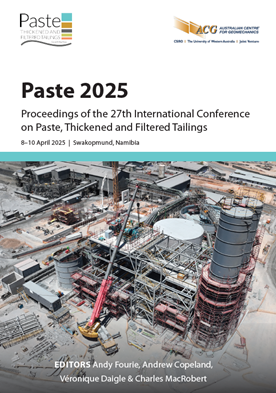From conceptual design to progressive closure of a dry-stack in a high seismic and tropical setting: a case history

|
Authors: Cobos, D; Crystal, C; Ariza, A |
DOI https://doi.org/10.36487/ACG_repo/2555_51
Cite As:
Cobos, D, Crystal, C & Ariza, A 2025, 'From conceptual design to progressive closure of a dry-stack in a high seismic and tropical setting: a case history', in AB Fourie, A Copeland, V Daigle & C MacRobert (eds), Paste 2025: Proceedings of the 27th International Conference on Paste, Thickened and Filtered Tailings, Australian Centre for Geomechanics, Perth, pp. 705-716, https://doi.org/10.36487/ACG_repo/2555_51
Abstract:
The Buriticá Gold Project is located in Antioquia, northern Colombia. Planning and design encompassed two years of fast-tracked pre-feasibility and feasibility studies, and stacking plan development. However, start-up and early operations were challenged by unanticipated differences in site climate and topographic setting, despite similar rainfall expectations. Changes in mine ownership and processing approaches, pandemic restrictions, minimal underground backfill availability due to social issues, restricted starter cell footprints, and filter plant start-up issues all converged to result in poor dewatering efficiency, high moisture and poor compaction control within the first cell of the tailings storage facility (TSF) in the first 6–12 months, and a steep learning curve for the operations and construction quality assurance teams. This paper presents a case study overview of the 2,500 tpd operation, summarising the pre and post-start-up observational method approach to both tailings characterisation, placement, handling and compaction specifications refinement, ongoing geotechnical monitoring and lessons from the progressive closure procedures and challenges of the actual versus originally conceived construction approaches for this project. Use of unique co-disposal, foundation excavation geometries and reinforcing design elements as well as tight moisture conditioning and compaction control are employed to overcome siting and footprint constraints, imposed height restrictions, low liner interface strengths and other challenges; while providing for global stability. Managing key risks, including designing for safe passage of potential probable maximum flood) flood and debris flow events on the adjacent Bermejal creek. Internal drainage and a double-liner with a leak detection system was installed to manage contact water and seepage. Progressive reclamation of the outer slopes supports non-contact water management, minimises air-entry and promotes vegetation growth and dust management – particularly for community access between isolated villages located upstream and downstream of the property. The success of the project is due not only to both diligently communicating and advocating for strict adherence to the original design intent through ownership and Engineer of Record (EoR) changes, but also allowing for flexibility in the observational approach and developing strong relationships and communication through the engineering, construction quality assurance and operations crews. The diligent shepherding of the project by in-country EoRs and Deputies, provide continuity to the project, allowing for transparent communication of the project challenges, risks and successes directly with communities and regulatory agencies; which has resulted in positive performance of the project, with expansions beyond the original approvals now being considered because of the demonstrated performance.
Keywords: dry stack tailings, progressive reclamation, filtered tailings, TSF performance
References:
Norambuena Mardones, RE, Caldwell-Crystal, C & Cobos, D 2023, ‘How high is too high? Challenges on the next generation of dewatered tailings stacks’, in GW Wilson, NA Beier, DC Sego, AB Fourie & D Reid (eds), Paste 2023: Proceedings of the 25th International Conference on Paste, Thickened and Filtered Tailings, University of Alberta, Edmonton, and Australian Centre for Geomechanics, Perth, pp. 465–479,
O’Kelly, BC & Sivakumar, V 2014, ‘Water Content determinations for peat and other organic soils using the oven-drying method’, Drying Technology, vol. 32, no. 6, pp. 631–643,
Robertson, PK & Cabal KL 2012, Guide to Cone Penetration Testing for Geotechnical Engineering, 5th edn, Gregg Drilling & Testing, Inc, Benicia.
Sousa Silva, J, Cezar Rissoli, A, Pazzoto Cacciari, P, Pereira Viana da Fonseca, A, Scheuermann Filho, H, Wagner, A, ... Consoli, N 2024, ‘Triaxial testing response of compacted iron ore tailings considering a broad spectrum of confining pressures’, Soils and Foundations, vol. 64, no. 2,
SRK Consulting 2022, Updated TSF Designs, Buriticá Project, SRK Consulting.
Zijin & Continental Gold, 2022, Mina Buriticá, Presentación General, presentation to Colombian authorities,
© Copyright 2025, Australian Centre for Geomechanics (ACG), The University of Western Australia. All rights reserved.
View copyright/legal information
Please direct any queries or error reports to repository-acg@uwa.edu.au
View copyright/legal information
Please direct any queries or error reports to repository-acg@uwa.edu.au
